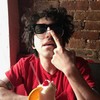MICHAEL ST. JOHN, Slaughter House Power to the People. 2016 acrylic, collage, polymer on canvas 5 1/2 x 24 1/2 x 23 1/2 inches (14 x 62.2 x 59.7 cm) © Michael St. John Photographer: Pierre Le Hors
MICHAEL ST. JOHN, Postings. 2016 collage, acrylic, plastic, tape, polymer on MDF 72 x 10 x 10 inches (182.9 x 25.4 x 25.4 cm) © Michael St. John Photographer: Pierre Le Hors
MICHAEL ST. JOHN, Gun Crazy. 2016 spray paint, acrylic, collage, polymer on canvas 48 x 72 inches (121.9 x 182.9 cm) © Michael St. John Photographer: Pierre Le Hors
MICHAEL ST. JOHN, Birthright. 2015 acrylic, collage, wood, polymer on canvas 48 x 72 inches (121.9 x 182.9 cm) © Michael St. John Photographer: Pierre Le Hors
MICHAEL ST. JOHN, No Floor. 2016 spray paint, acrylic, collage, plastic, polymer on canvas 48 x 72 inches (121.9 x 182.9 cm) © Michael St. John Photographer: Pierre Le Hors
LEO GABIN, Boston. 2013 Polyurethane resin, fiberglass, lacquer 5 1/8 x 9 5/16 x 7 5/8 inches (13 x 23.6 x 19.3 cm) © Leo Gabin Photographer: Pierre Le Hors
MICHAEL ST. JOHN, in the days of 49. 2014 collage on paper 12 x 12 inches (30.5 x 30.5 cm) Framed: 15 3/8 x 15 3/8 inches (39.1 x 39.1 cm) © Michael St. John Photographer: Pierre Le Hors
